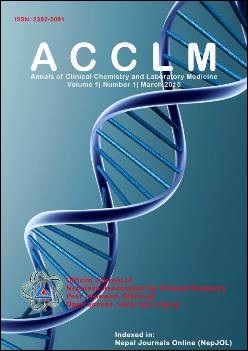Types of Dyslipidemia in Type 2 DM Patients of Bhubaneswar region
DOI:
https://doi.org/10.3126/acclm.v1i1.12313Keywords:
Type-2 Diabetes Mellitus, Dyslipidemia, Lipid Profile, Triglyceride, HDL-C, LDL-C, Total CholesterolAbstract
BACKGROUND: A characteristic pattern, termed dyslipidemia, consists of deranged of any single components of lipid profile test. This pattern is most frequently seen in diabetes and may be a preventable risk factor for subsequent cardiovascular disease. This study determined the influence of type 2 diabetes mellitus (T2DM) on lipid profile of diabetic patients reporting in a tertiary hospital in Bhubaneswar, India.
METHODS: 50 confirmed T2DM patients and 50 non-diabetic control subjects were selected for the study. Fasting and 2 hours post prandial blood samples were collected from both study and control patients. Fasting blood sample was analyzed for lipid profile test and serum glucose, and post prandial sample was analyzed for serum glucose only.
RESULTS: Sixty two (62%) of diabetic patients were males whilst thirty eight (38%) were females in this study. The mean plasma glucose levels, Total cholesterol and Triacylglycerol were significantly raised in the diabetics as compared to those in the control subjects. This is substantiated by the fact that the entire lipid fractions are disturbed in diabetics as compared to healthy controls.
CONCLUSION: Thus dyslipidemia was quite common in diabetes and Hypertriglyceridemia was the most common one.
DOI: http://dx.doi.org/10.3126/acclm.v1i1.12313
Ann. Clin. Chem. & Lab. Med. 1(1) 2015: 33-36
Downloads
Downloads
Published
How to Cite
Issue
Section
License
Authors who publish with this journal agree to the following terms:
- The author transfers copyright to the Nepalese Association for Clinical Chemistry.
- The journal publishes the work under a Creative Commons Attribution License that allows others to share the work with an acknowledgement of the work's authorship and initial publication in this journal and under the same share-alike license used here.
- Authors are able to enter into separate, additional contractual arrangements for the non-exclusive distribution of the journal's published version of the work (e.g., post it to an institutional repository or publish it in a book), with an acknowledgement of its initial publication in this journal.
- Authors are permitted and encouraged to post their work online (e.g., in institutional repositories or on their website) prior to and during the submission process, as it can lead to productive exchanges, as well as earlier and greater citation of published work (See The Effect of Open Access).




